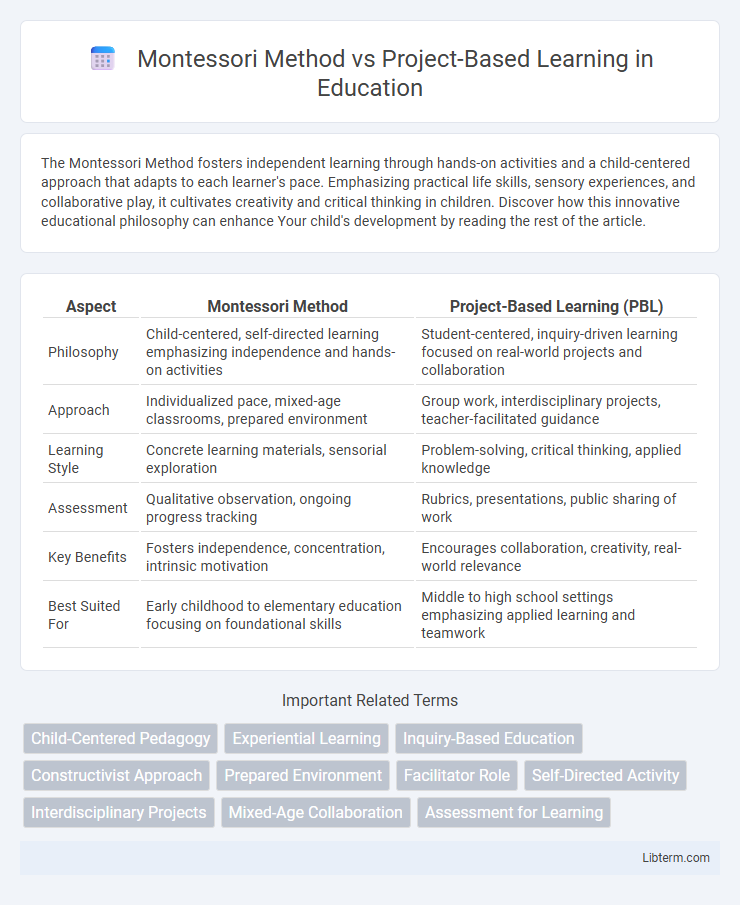The Montessori Method fosters independent learning through hands-on activities and a child-centered approach that adapts to each learner's pace. Emphasizing practical life skills, sensory experiences, and collaborative play, it cultivates creativity and critical thinking in children. Discover how this innovative educational philosophy can enhance Your child's development by reading the rest of the article.
Table of Comparison
| Aspect | Montessori Method | Project-Based Learning (PBL) |
|---|---|---|
| Philosophy | Child-centered, self-directed learning emphasizing independence and hands-on activities | Student-centered, inquiry-driven learning focused on real-world projects and collaboration |
| Approach | Individualized pace, mixed-age classrooms, prepared environment | Group work, interdisciplinary projects, teacher-facilitated guidance |
| Learning Style | Concrete learning materials, sensorial exploration | Problem-solving, critical thinking, applied knowledge |
| Assessment | Qualitative observation, ongoing progress tracking | Rubrics, presentations, public sharing of work |
| Key Benefits | Fosters independence, concentration, intrinsic motivation | Encourages collaboration, creativity, real-world relevance |
| Best Suited For | Early childhood to elementary education focusing on foundational skills | Middle to high school settings emphasizing applied learning and teamwork |
Overview of Montessori Method and Project-Based Learning
The Montessori Method emphasizes child-centered learning through hands-on activities, fostering independence and self-directed exploration in a prepared environment tailored to developmental stages. Project-Based Learning centers on students investigating real-world problems or challenges over extended periods, encouraging collaboration, critical thinking, and practical application of knowledge. Both approaches promote active learning but differ in structure, with Montessori offering an individualized framework and Project-Based Learning focusing on group-driven inquiry.
Historical Background of Both Approaches
The Montessori Method, developed by Dr. Maria Montessori in the early 20th century, emphasizes child-led learning and sensory-based education with roots in her observations of children's natural development. Project-Based Learning (PBL) emerged later in the mid-20th century, influenced by educational theorists like John Dewey, focusing on experiential learning through collaborative projects to solve real-world problems. Both approaches reflect progressive education philosophies but differ in structure, with Montessori centered on individualized self-paced learning and PBL prioritizing group interaction and active problem-solving.
Core Principles and Philosophies
Montessori Method emphasizes self-directed learning, individualized pacing, and hands-on materials to foster independence and intrinsic motivation. Project-Based Learning centers on collaborative, inquiry-driven projects that develop critical thinking, problem-solving, and real-world application skills through active exploration. Both approaches prioritize experiential learning but differ in structure, with Montessori focusing on personal autonomy and Project-Based Learning on collective, goal-oriented tasks.
Classroom Environment and Setup
Montessori classrooms feature carefully prepared environments with child-sized furniture and materials designed to promote independence, sensory exploration, and self-directed learning, emphasizing order and accessibility. Project-Based Learning environments prioritize flexible, collaborative spaces with resources and technology that support teamwork, creativity, and real-world problem solving, often incorporating movable furniture to adapt to various project needs. Both setups optimize engagement but Montessori's structured, individualized approach contrasts with Project-Based Learning's dynamic, group-focused design.
Role of the Teacher
In the Montessori Method, the teacher acts as a guide, facilitating a prepared environment where students independently explore and learn at their own pace. In contrast, Project-Based Learning requires teachers to take on a more active role as facilitators who design meaningful projects and support collaboration, critical thinking, and problem-solving skills. Both approaches emphasize student-centered learning but differ significantly in the teacher's involvement and instructional strategies.
Student Engagement and Autonomy
The Montessori Method emphasizes student autonomy by allowing learners to choose activities that align with their interests, fostering intrinsic motivation and deep engagement. Project-Based Learning enhances student engagement through collaborative, real-world problem-solving projects that require active participation and critical thinking. Both approaches promote autonomy and engagement, but Montessori centers on individualized, self-directed learning while Project-Based Learning prioritizes teamwork and applied knowledge.
Curriculum Structure and Content Delivery
The Montessori Method features a child-centered curriculum with self-directed activity and hands-on learning materials that foster independence and sensory exploration. Project-Based Learning emphasizes collaborative, real-world projects that integrate multiple subjects, promoting critical thinking and problem-solving through active inquiry. Montessori classrooms offer individualized pacing and choice, while PBL environments structure content around complex tasks that require teamwork and interdisciplinary application.
Assessment and Evaluation Methods
Montessori Method emphasizes observational assessment and self-evaluation, allowing students to demonstrate mastery through hands-on activities and personalized progress tracking. Project-Based Learning employs formative and summative assessments, including peer reviews, presentations, and reflective journals that evaluate collaboration, critical thinking, and real-world problem-solving skills. Both methods prioritize authentic assessments that align with experiential learning and individual growth.
Benefits and Challenges of Each Method
The Montessori Method promotes self-directed learning and hands-on activities, fostering independence and critical thinking, but it can challenge educators to balance freedom with structure and may require specialized training. Project-Based Learning (PBL) enhances collaboration, problem-solving skills, and real-world application of knowledge, though it often demands significant planning and resources and can be difficult to assess objectively. Both methods support active learning but require adapting to diverse student needs and educational contexts for maximum effectiveness.
Which Educational Approach Fits Your Child Best?
Montessori Method emphasizes individualized learning through hands-on activities and self-paced exploration, ideal for children who thrive in structured yet flexible environments fostering independence. Project-Based Learning centers on collaborative, real-world problem-solving projects that develop critical thinking and teamwork skills, suited for children who excel in dynamic, social, and experiential settings. Assess your child's learning style, social preferences, and motivation to determine whether the self-directed or interactive project framework best supports their educational growth.
Montessori Method Infographic

 libterm.com
libterm.com